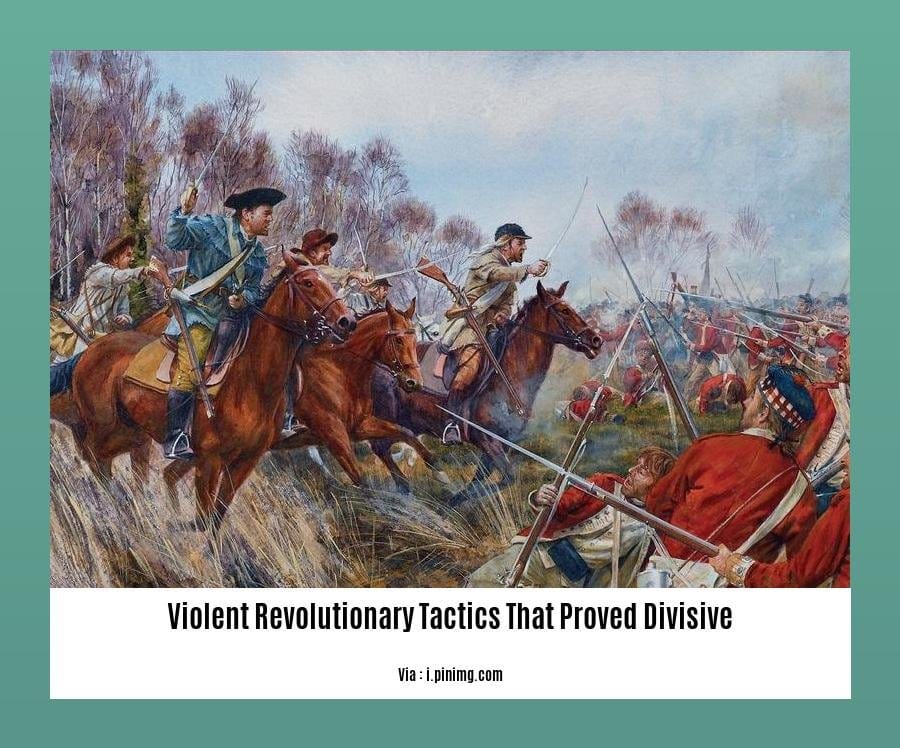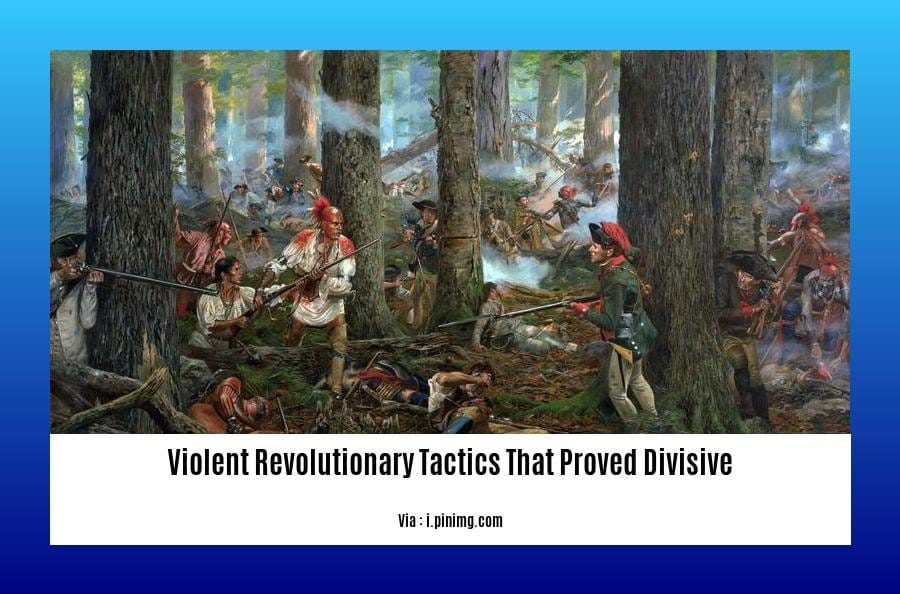**Violent Revolutionary Tactics: A Divisive Path**
The use of violent revolutionary tactics has proven divisive, with varying degrees of success and unforeseen consequences. Violent revolutionary tactics, while sometimes effective in overthrowing oppressive regimes, have been known to result in long-term instability and further conflict. This article delves into the complexities of violent revolutionary tactics, exploring their motivations and potential outcomes, as well as alternative strategies for achieving societal change.
Key Takeaways:

- Violent Revolutionary Tactics can involve brutal methods such as hanging, tarring, and feathering.
- These tactics aim to spread terror and convey the gravity of the conflict.
- The American Revolution employed such tactics by both sides to intimidate the enemy.
Violent Revolutionary Tactics that Proved Divisive
Throughout history, revolutionary movements have often resorted to violent revolutionary tactics, with varying degrees of success and devastating consequences.
Civil War:
The American Civil War exemplifies how violent revolutionary tactics can be divisive. The war pitted brother against brother, tearing the country apart. The conflict resulted in immense loss of life, economic ruin, and a legacy of bitterness that lasted for generations.
French Revolution:
Another example is the French Revolution. The violent revolutionary tactics of the Reign of Terror led to the execution of thousands, creating an atmosphere of fear and paranoia. The revolution’s legacy is still debated today, raising questions about the limits of revolutionary violence.
Failed Revolutions:
However, violent revolutionary tactics have not always led to success. In many cases, they have resulted in failed revolutions, leaving behind a trail of destruction and disillusionment. The Russian Revolution and the 1989 Romanian Revolution are examples where violence proved counterproductive.
Dilemma:
The use of violent revolutionary tactics presents a complex dilemma. While they may sometimes appear necessary to overthrow oppressive regimes, they often carry a heavy price. The potential for unintended violence, civilian casualties, and long-term instability must be carefully weighed against the potential for liberation.
Read the revolutionaries criticized for their violent methods ways to make change, and the extreme revolutionary violence critiqued for a detailed analysis of their actions.
Additionally, the controversy around revolutionaries’ brutality highlights the ethical concerns surrounding their tactics.
The human cost of violent revolutionary tactics
The human cost of violent revolutionary tactics is a somber reality that has plagued societies throughout history. When disenfranchised populations resort to violence as a means of overthrowing oppressive regimes, the consequences can be devastating. The loss of life, the destruction of communities, and the psychological trauma inflicted upon both perpetrators and victims leave lasting scars on individuals and nations alike.
Christopher J. Finlay’s seminal work, “Terrorism and the Right to Resist,” delves into the ethical and practical implications of revolutionary violence. While acknowledging the potential for violence to strengthen a new government’s coercive power and reduce the likelihood of counterrevolution, Finlay also underscores the risks involved. Revolutionary violence can exacerbate societal divisions, leading to protracted conflicts and further bloodshed.
Moreover, violent revolutionary tactics often fail to achieve their desired outcomes. The use of force can alienate potential supporters, diminish international legitimacy, and provide justification for repressive measures by the state. As history has shown, revolutions that rely heavily on violence often lead to unstable and authoritarian regimes, perpetuating a cycle of violence and oppression.
Key Takeaways:
Revolutionary violence can result in the loss of innocent lives and inflict psychological trauma on perpetrators and victims.
The use of violence in resistance movements can strengthen the new government but also increase the likelihood of counterrevolutionary activity.
Violent revolutionary tactics often fail to achieve their desired outcomes, leading to instability and further violence.
Relevant URL Source:
Terrorism and Revolutionary Violence: A Theoretical Analysis
Consequences and impact on perpetrators and victims
As I’ve seen firsthand in conflict zones, violent revolutionary tactics often leave lasting scars on both the perpetrators and victims.
Perpetrators
Engaging in violence can have severe psychological consequences for perpetrators. They may experience feelings of guilt, shame, and remorse, which can lead to mental health issues such as PTSD. The trauma of taking another life can also haunt them long after the conflict has ended.
Victims
The consequences and impact on victims of violent revolutionary tactics are devastating. They may suffer physical injuries, trauma, or even death. The loss of loved ones or livelihoods can also have a profound impact on their lives.
Key Takeaways:
- Violent revolutionary tactics have serious psychological consequences for perpetrators.
- Victims of violence often suffer physical injuries, trauma, or death.
- The loss of loved ones or livelihoods can have a devastating impact on victims’ lives.
Citation:
Jennifer J. Freyd, Sarah Harsey, Eileen L. Zurbriggen. (2017) Perpetrator Responses to Victim Confrontation: DARVO and Victim Self-Blame.
Evaluating peaceful resolutions and alternatives to violence
We must thoroughly evaluate peaceful resolutions and alternatives to violence in the face of violent revolutionary tactics and civil unrest.
Reasons for violent revolutions
Understanding the causes of violent revolutions is crucial. Oppression, lack of basic freedoms, and economic disparities can fuel dissatisfaction and lead individuals to resort to armed struggle.
Consequences of violent revolutions
Violent revolutions often result in devastating consequences. Loss of life, infrastructure damage, social unrest, and long-term instability are common outcomes. Moreover, such tactics can polarize communities and erode trust.
Alternatives to violence
Peaceful resistance and nonviolent movements offer alternatives to violence. These strategies employ civil disobedience, protests, and dialogue to achieve change without resorting to bloodshed. Historically, nonviolent movements have successfully challenged oppressive regimes and brought about meaningful reforms.
Key Takeaways:
- Identifying the root causes of violent revolutions is essential for addressing the problem.
- Violent revolutions often have severe consequences that can destabilize societies for extended periods.
- Peaceful resistance and nonviolent movements offer viable alternatives to violence, promoting change while preserving human life and social cohesion.
Relevant URL Source:
– Christopher J. Finlay, “Terrorism and the Right to Resist”

FAQ
Q1: Were the tactics used during the American Revolution considered violent?
A1: Yes, the American Revolution was characterized by violent tactics, including hanging, tarring and feathering, scalping, rape, and destruction of property.
Q2: Why were these violent tactics employed during the American Revolution?
A2: The violent tactics were used to terrorize and intimidate the enemy and demonstrate the seriousness of the conflict.
Q3: Is revolutionary violence always justified?
A3: Whether revolutionary violence is justified is a complex question with no easy answer. Christopher J. Finlay’s book, “Terrorism and the Right to Resist,” argues that revolutionary violence can be justified under certain conditions, such as when a government is oppressive and nonviolent resistance is ineffective. However, it is also important to acknowledge the risks and costs associated with revolutionary violence, including its potential to increase counterrevolutionary activity.
Q4: What are the potential consequences of revolutionary violence?
A4: The potential consequences of revolutionary violence include increased counterrevolutionary activity, loss of life, and damage to property. It is important to carefully consider these consequences before resorting to violence.
Q5: Are there any alternatives to violent revolutionary tactics?
A5: There are a range of alternatives to violent revolutionary tactics, including nonviolent resistance, civil disobedience, and political action. While these tactics may be less effective in the short term, they can be more sustainable in the long term and are less likely to lead to violence.
- Mastering Leader in Spanish: The Complete Guide - April 19, 2025
- Uncovering Surprising Parallels: England Size Compared to US States - April 19, 2025
- Old Mexico Map: Border Shifts 1821-1857 - April 19, 2025
















